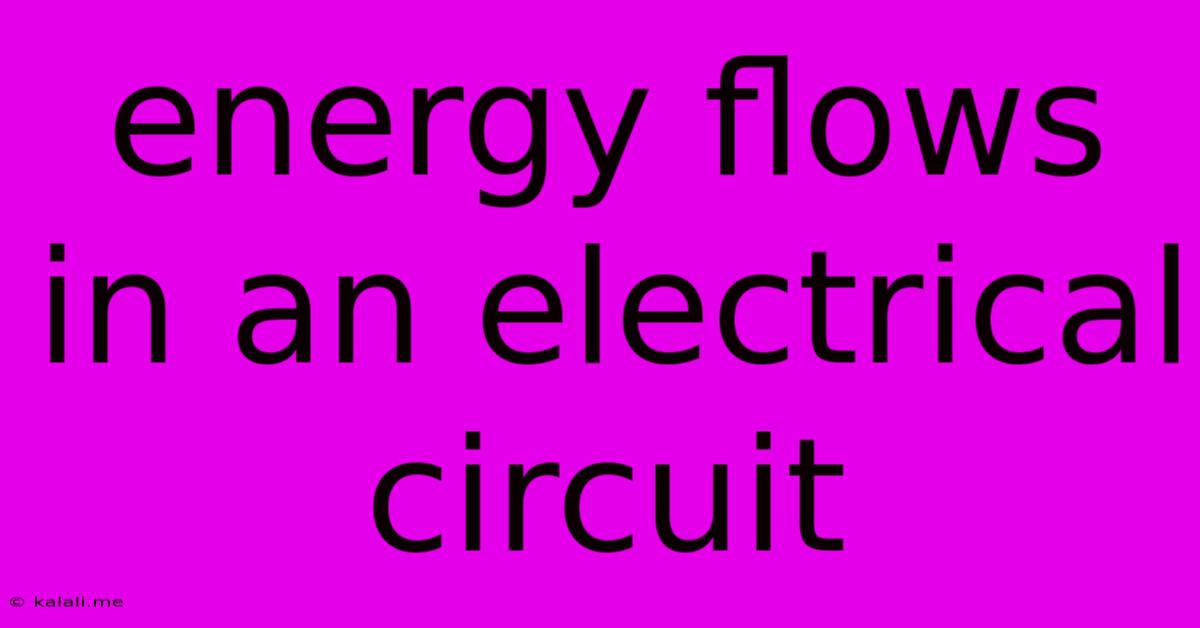Energy Flows In An Electrical Circuit
Kalali
Jun 07, 2025 · 4 min read

Table of Contents
Energy Flows in an Electrical Circuit: A Comprehensive Guide
Understanding how energy flows in an electrical circuit is fundamental to comprehending electricity itself. This article will explore the intricacies of this flow, from the basic principles to more advanced concepts, making it accessible to both beginners and those seeking a deeper understanding. We'll cover key terms, explore different circuit types, and delve into the practical applications of this knowledge.
What is an Electrical Circuit?
At its core, an electrical circuit is a closed loop providing a path for electric current to flow. This current, a flow of electric charge, typically consists of electrons moving through a conductive material like copper wire. For the current to flow continuously, there must be a source of electromotive force (EMF), usually a battery or power supply, that provides the potential difference (voltage) driving the electrons. The circuit also includes components such as resistors, capacitors, and inductors which influence the flow of current. Understanding these components is key to understanding energy flow.
The Flow of Energy: Voltage, Current, and Resistance
Three key elements define the energy flow within a circuit:
-
Voltage (V): This represents the electrical potential difference between two points in the circuit. It's the "push" that drives the electrons. Think of it as the water pressure in a pipe; higher pressure means more forceful water flow. Voltage is measured in volts (V).
-
Current (I): This refers to the rate of flow of electric charge. It's the actual movement of electrons through the circuit. Using the water analogy, current is the amount of water flowing through the pipe per unit of time. Current is measured in amperes (A) or amps.
-
Resistance (R): This is the opposition to the flow of current. It's a property of the materials in the circuit, with some materials offering more resistance than others. In our water analogy, resistance is like the pipe's diameter; a narrower pipe restricts the water flow more than a wider one. Resistance is measured in ohms (Ω).
These three are related by Ohm's Law: V = IR. This fundamental law governs the relationship between voltage, current, and resistance in a simple circuit.
Types of Electrical Circuits:
Several types of circuits exist, each with its own characteristics regarding energy flow:
-
Series Circuits: In a series circuit, components are connected end-to-end, forming a single path for current flow. The current is the same throughout the circuit, but the voltage is divided across each component. A break in any part of the circuit stops the flow completely.
-
Parallel Circuits: In a parallel circuit, components are connected across each other, providing multiple paths for current flow. The voltage is the same across each component, but the current is divided among them. A break in one branch of the circuit doesn't affect the flow in other branches.
-
Complex Circuits: Many circuits are combinations of series and parallel configurations, requiring more advanced analysis techniques to understand the energy distribution.
Energy Transformation and Power:
Energy in an electrical circuit is not just flowing; it's also being transformed. Components like resistors convert electrical energy into other forms, such as heat (incandescent light bulbs) or light (LEDs). The rate at which this energy is transformed is called power (P), calculated using the formula: P = IV or, using Ohm's Law, P = I²R = V²/R. Power is measured in watts (W).
Understanding Energy Flow in AC and DC Circuits:
The nature of energy flow differs slightly between alternating current (AC) and direct current (DC) circuits. In DC circuits, the current flows in one direction, while in AC circuits, the current periodically reverses direction. This difference impacts how energy is distributed and utilized within the circuit.
Practical Applications:
Understanding energy flow in electrical circuits is crucial across various applications:
-
Electronics Design: Designing efficient and effective electronic devices relies heavily on understanding current distribution and power dissipation.
-
Power Systems: Power grids and distribution networks are complex systems managing the flow of enormous amounts of energy, requiring intricate control and monitoring.
-
Renewable Energy: Harnessing renewable energy sources like solar and wind involves intricate circuit designs for efficient energy conversion and storage.
Mastering the principles of energy flow in electrical circuits is essential for anyone working with electricity. By understanding the relationships between voltage, current, resistance, and power, we can design, analyze, and troubleshoot a vast range of electrical systems, from simple circuits to complex power grids. This knowledge forms the bedrock of countless technologies that shape our modern world.
Latest Posts
Latest Posts
-
How To Connect A Three Way Switch
Jun 07, 2025
-
Use Whats Useful For Yourself Meaning
Jun 07, 2025
-
Google Sheets Copy Formula Without Changing Cell Reference
Jun 07, 2025
-
3 Way Dimmer Switch Wiring Schematic
Jun 07, 2025
-
Why Does Sebastian Want Ciels Soul
Jun 07, 2025
Related Post
Thank you for visiting our website which covers about Energy Flows In An Electrical Circuit . We hope the information provided has been useful to you. Feel free to contact us if you have any questions or need further assistance. See you next time and don't miss to bookmark.